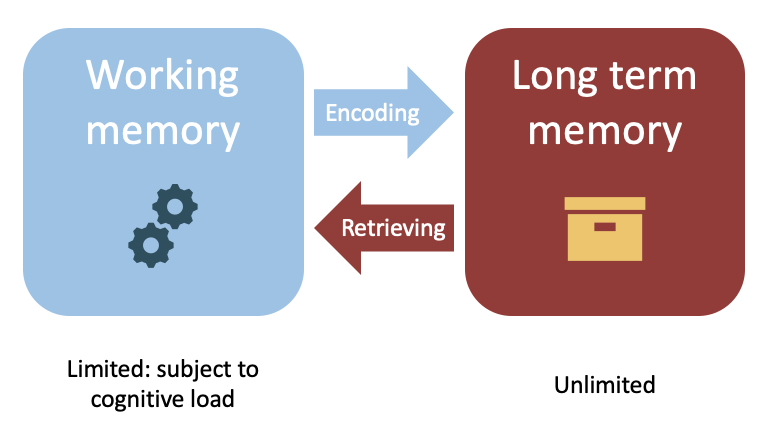Working memory is limited. Familiarity with how memory works can help address some of the challenges faculty face when trying to encourage deep and long-lasting learning in students.

Working memory refers to the memory used when actively engaged in thinking about a problem. It is very limited. Research suggests we are only able to attend to 7 or as few as 4 pieces of information at a time (Miller, 1956; Cowan, 2000). Once the working memory limit is reached, learning is greatly diminished.
Working memory encodes information into long term memory, which is nearly unlimited. Long term memory is where we store information. When we need to recall information stored in long term memory, we retrieve that information back into working memory where we can actively work with it. We can think of working memory as a bottleneck or the rate-limiting step of memory. We can overload the working memory of our students when we present too much new information without an opportunity to consolidate it.
Cognitive Load Theory refers to a body of research that examines the capabilities and limitations of human cognition (Plass, 2010). There are 3 elements that contribute to cognitive load:
- Intrinsic cognitive load refers to the innate difficulty of the task
- Germane cognitive load refers to the capacity of working memory to link new ideas with information in long term memory
- Extraneous cognitive load refers to limits caused by factors not related to the problem at hand
These factors include the materials and environment we expose students to. These factors tax working memory but are not related to the problem itself. An example of factors that could increase the extrinsic cognitive load a student experiences include:
- Filtering outside noise or distractions
- Working with materials outside their primary language
- Encountering confusing wording, typos, poor contrast, grammar and spelling errors present in required texts
- Perceiving learning environments as threatening and/or unsafe
Strategies for limiting the cognitive overload of your students

- Insert breaks for students to assimilate information. Because working memory is subject to cognitive overload, it is useful to insert short breaks into our lectures to allow students to take actions to encode new information. Think of working memory as an empty glass. When it is full, additional information overflows out of the glass. Breaks provide students with time to empty the glass and be ready for more.
- A simple way to do this is to break up long stretches of lecture with short breaks for students to consolidate their notes, turn to their neighbor to discuss or ask questions, or introduce a classroom assessment technique (CAT) that provides students and instructors with feedback on student understanding. Even two two-minute breaks can improve student performance (Ruhl, 1987).
- Provide navigation throughout the learning sessions. This can be done by 1) providing students with an outline (sometimes referred to as an advanced organizer) at the beginning of a class session that previews the learning outcomes and activities for the session and 2) referring to the outline milestones throughout the session. This can be accomplished by inserting slides that indicate you are finishing one concept and moving on to the next concept or verbally articulating a transition e.g. “We’ve finished discussing the first principle, now let’s move on to the next principle” (Titsworth, 2004; Lang, 2016). And finally, 3) provide a quick summary at the end reviewing the learning outcomes and re-emphasizing the main points.
- Use a graphic organizer. An organizing framework in the form of a graphic organizer allows students to see where new information fits within a larger schema. Most students come to our courses without an expert framework to assimilate new knowledge. We can help students begin to think like an expert by revealing how we organize information.
- This can take the form of a hierarchical, sequential, process-based or other framework (Robinson, 1995; Ambrose, 2010; McCrudden, 2017; Colliot, 2018).
- Reduce extraneous cognitive load (de Jong, 2009). Instructors should work to identify any factors that might contribute to the extraneous cognitive load of their students and endeavor to eliminate or reduce them. Reduce extraneous cognitive load by:
- Creating accessible readings, slides, and other course materials that are clear, uncluttered, of high contrast, and accessible by practicing the 7 core skills for accessibility
- Removing irrelevant images or texts from slides, presentation, posters, and other visually presented course materials
- Creating a supportive classroom climate where students feel valued and appreciated. Review the class climate section of the CEI resource on Inclusive Teaching at a Predominantly White Institution resource to learn more about this